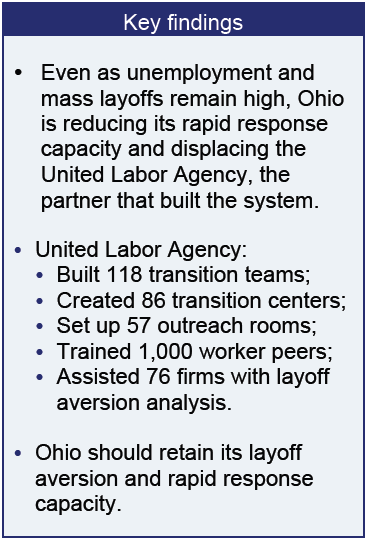
Wrong Direction: Ohio retreats on layoff aversion
September 24, 2012
Wrong Direction: Ohio retreats on layoff aversion
September 24, 2012
Download reportPress releaseIt is puzzling, in this economy, that the state would reduce rapid response capacity and fail to renew a contract with a high-performing partner that has successfully helped so many workers.
The Workforce Investment Act (WIA) requires the state, or an entity designated by the state, to provide rapid response services when events, such as disasters, mass layoffs, or plant closings, substantially add to the number of unemployed Ohioans.
 Since 2007, Ohio has contracted with the United Labor Agency (ULA) to avert layoffs, coordinate statewide activities, and improve rapid response services to laid-off workers.[1]
Since 2007, Ohio has contracted with the United Labor Agency (ULA) to avert layoffs, coordinate statewide activities, and improve rapid response services to laid-off workers.[1]
The ULA has managed workforce development programing throughout its 41-year history. The 2007 program was established in response to rising layoffs and plant closures and increasing needs of dislocated workers. ULA is a contract provider of WIA services for Workforce Investment Board, Area 3, serving dislocated and adult workers. ULA has coordinated rapid response services for Cuyahoga County for the last twenty-years. The organization serves employers, unions, and non-union customers through the Employment Connection WIA programing.
ULA builds system
More than 20 states have rapid response contracts with labor or labor partners, as Ohio did under these arrangements. The state’s partnership with the ULA increased the state system’s capacity to provide rapid response services.
When ULA took on this work in 2007, there were only two transition teams in the state, no peer support programs, and only three transition centers. As the state-designated rapid response entity, ULA helped build 120 transition teams, 89 transition centers, and 57 outreach rooms to plan and support workers during dislocation events. The ULA trained 1,000 worker peers to provide information and support to coworkers. (See Table 1.)
Through these worker peers, transition teams, transition centers and outreach rooms, the ULA was able to refer workers to local workforce investment boards, which in turn provided training and placement services. The program has also assisted 76 companies through a comprehensive layoff aversion analysis. Fifty-eight of these, or 76 percent, implemented layoff aversion strategies.
Non-renewal a setback for workers, state
ULA’s contract expired in August and is not being renewed, although some components of the ULA program may be contracted out to new service providers.
According to federal guidelines, rapid response teams must assess the potential for averting layoffs.[2] WIA also permits the state, in conjunction with other stakeholder groups such as industry business councils and labor organizations, to develop strategies to promote rapid access to assistance.
The U.S. Department of Labor has found labor to be an important partner in rapid response programs because workers can provide early warning intelligence regarding struggling companies, can provide access and information on training and reemployment, and can train peer counselors. The ULA contract helped the state achieve these goals.
It does not make sense to reduce rapid response capacity in an economy that continues to displace so many workers. Ending the formal relationship between labor and rapid response or layoff aversion systems is a step in the wrong direction. Even though the state is experiencing modest job growth, mass layoffs are on the increase in 2012. The Worker Adjustment Retraining Notification (WARN) Act requires employers with more than 100 employees to provide 60 days advance notice of plant closures or mass layoffs. Table 2 shows the number of notices filed and the number of workers impacted since 2009. The 2012 figures include notices filed through August 2012.
The overall number of mass layoff notices and impacted workers is considerably and thankfully down nearly 70 percent from 2009 numbers, the last year of the 2007 recession. Yet, mass layoffs remain at a high and destabilizing level. 2012 WARN filings have already surpassed the 2011 total, both in the number of petitions filed and the number of workers impacted. Plus, with four months left in the year, there are more petitions to come. Now is not the time to reshuffle or reduce rapid response services.
WARN filings also highlight the need for the state to retain a labor organization as a rapid response partner. Figure 1 shows WARN-impacted workers by union status. Since 2009, more than half of all workers impacted by mass layoffs were in a unionized workplace.
Conclusion and recommendations
[caption id="attachment_11908" align="alignright" width="240" caption="Photo by Steve Cagan"] [/caption]
[/caption]The Department of Labor has named labor as an important partner in rapid response and layoff aversion programs. More than 20 states follow the recommendation. Ohio identified a strong and competent partner in the ULA, which did an excellent job of establishing an infrastructure and increasing referrals to local WIBS for displaced workers. The majority of WARN-impacted workers in the state belong to a union. The state should follow federal advice and maintain a rapid response system that can best meet the needs of workers and employers and that reflects the composition of mass-layoff employers. In Ohio, that means including labor as a partner.
Rapid response and successful layoff aversion is built on critical partnerships between the state, labor, the employer, and the local community. Reducing Ohio’s capacity to avert and respond to layoffs makes no sense in this economy. Cutting out a high-performing partner hurts the system. Ohio should reinstate a strong rapid response and layoff aversion system that includes the solid partners who helped establish and grow the successful model that is now in place.
[1] David Megenhardt, the executive director of ULA, is a member of the Policy Matters Ohio board of directors.
[2] See, WIA regulations at 665.310
Tags
2012State of Working OhioWork & WagesPhoto Gallery
1 of 22


